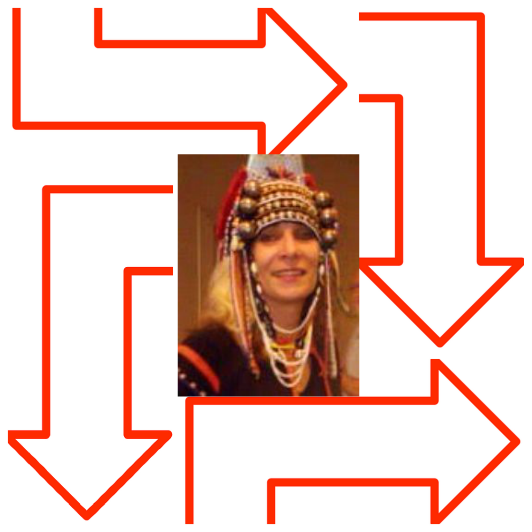
With this post, Indra Chopra wraps up her account of life as a privileged expat spouse, which she found just as enriching in Asia as she did in the Middle East. Hm, can a memoir be far off?—ML Awanohara
To continue where I left off in my last installment: Expat life in Hong Kong spoiled me. There was such a range of things and experiences to try, whether it was the cuisine, from street food to sumptuous banquets; apparel, from local brands to top designers; or sightseeing, from standard to offbeat adventures.
My one regret was that I was at least a decade late to the party. Hong Kong feels like a young person’s habitat. It’s a land of opportunity and, when it comes to activities, one is spoilt for choice.
My old stomping—or is it dawdling?—grounds in Hong Kong
While I’m not exactly a doddering dowager, over the years my priorities have changed to something more staid. In the initial months following our arrival, I would dawdle away several hours along Nathan Road, Kowloon’s main thoroughfare. I would start at the iconic Peninsula Hotel, which flaunts its large fleet of customized Rolls-Royce Phantoms (painted “Peninsula green”) and an afternoon tea that is served in the aristocratic ambience of colonial times—features that have earned it the epithet “Grande Dame of the Far East”.
I studiously avoided the blatant commercialism of the shopping arcades and new malls, the ubiquitous sellers of “genuine fake” watches, the touristy gift shops, and the crowded dai pai dongs (open-air food stalls).
Instead I would meander towards the quirky neighborhood of Yau Ma Tei and then would move on to Jordan, an area full of countless small shops, which also has a seedier side. One can sometimes glimpse dimly lit stairways to massage parlors or off-limits clubs with bouncers ready to bounce you back into the neon-lit pavement and the dense pedestrian and vehicular traffic, not to mention the continuous projection of entertainment, things for sale, and cultural attractions constantly trying to lure you in.

Indra’s stomping—or is it dawdling?—grounds in Hong Kong
Getting from A to B has never been easier!
We soon acquired our Permanent IDs and Hong Kong driver’s licenses, which provided a feeling of security. Every six months or so, we would review our plans to purchase a car, only to be dissuaded by well-meaning friends, who would point to the traffic and exorbitant parking fees.
As it turned out, our flat didn’t come with a parking space—or maybe it did but the landlord rented it separately.
Another reason for dithering was that Hong Kong’s public transport system is convenient, reliable and always-on time. I still feel embarrassed thinking back to an occasion when I was meeting with some friends for a day out. New to Hong Kong, I gave myself a margin of one hour only to arrive in 20 minutes flat (and that was after a couple of changes, from the hotel shuttle to the Mass Transit Railway, or MTR, and from one subway line to another). My friends were surprised to hear I’d set out so early. I was calculating by Indian Standard Time, a euphemistic expression that acknowledges we Indians are always late.
Another advantage of public transport was that it helped me hone my pronunciation skills, providing a chance to reify such fuzzy place names as Fung Yuen, Ting Kok, Tai Mei Tuk, Sha Tau Kok, Wo Keng Shan, Yuen Po Street, Yuen Ngai Street, Yim Po Fong Street, Hak Po Street, etc. I would jot down these names in my iPhone but the words would soon fade.
For a long time I thought Pok Fu Lam was a pork dish until someone pointed out it is one of Hong Kong’s high-end areas! Landmarks were easier to remember except on the occasions when the store/café/cha chaan teng (tea houses)/dai pai dong/fish stall in question had disappeared overnight.
Knowing that one could rely on the MTR (or other public transport) for my escape was a welcome thought whenever I would become overwhelmed by Hong Kong’s busy cafes, book stores, convenience stores, posh shops, popular hiking spots, beaches…

The joys of riding the MTR
Exploring to my heart’s content
As an expat, I am more inquisitive than acquisitive. I did not want to waste energy in “keeping up with Joneses” and relished my anonymity, a status that permitted me to explore to my heart’s content. I would amble through neighborhoods, mysterious alleys, busy and deserted city streets, temples and pubs, the promenades (Tsim Sha Tsui, West Kowloon), Central Hong Kong, Aberdeen, the outlying islands, mountain paths… I would hop on to ferries/MTR/buses in search of the unfiltered and unlisted.
I never felt self-conscious venturing out on my own, nor did I look over my shoulder. It felt safe and normal to be a solo female in pursuit of my own little adventures.
At the beginning I would seek advice from friends, but in due course I could plan a day’s outing by using guides and maps. I would select a destination that was manageable for my walking level, from the crowded to the remote. Hong Kong is blessed with hundreds of islands, and I wanted to cover as much as I could.

So much territory to cover, so little time!
In the expat life, wonders never cease
Life was a kind of party for me until 2013, when we decided to move back to our home base: Gurgaon, India. After that we had a life of reverse travel, staying in Hong Kong for stretches in furnished apartments. I missed the continuity of expat life and the opportunity it provides for participating in local events and other activities only insiders would hear about.
Some say that a major limitation of expat life is that feeling of dépaysement, the sense of disorientation that can come from being outside of your home country. To be honest, I never experienced this feeling in my long stays in Hong Kong or Oman, simply because to me home is, as my favorite travel chronicler, displaced Indian writer Pico Iyer has said, “not just the place where you happen to be born. It’s the place where you become yourself.”
In fact I often wonder how my personality would have developed had I stayed at home in the place of my birth/marriage and missed out on interactions with different nationalities and sensibilities, and been denied all the knowledge I obtained from other countries, all the many learning opportunities. There were times when I felt frazzled with the packing and unpacking and would envy friends and family living in their family homes and mansions, going for vacations and shopping abroad for a few months in a year. For them, “worldly possessions” always meant luxury.
But, then I would recall chance encounters I would have missed out on—for instance:
- My encounters with a fellow walker in the Qurum Natural Park Rose Garden, located in the heart of Muscat (Oman’s capital city). The lady would stop me to gush about my “luck” in speaking English, the idea being that English-speaking Indians were India’s biggest export, and about how she wanted her children to study the English language. After several such encounters, I stopped going to the park as I knew where it was headed…to an invitation to coach her children.
- The time in Salalah, Oman, when an acquaintance patted my stomach in show of remorse that I have “only two children” when she was expecting her sixth. I felt like telling her: “Lady, I am fortunate”; but desisted as we were her guests. Different countries and different takes…
- The time in New York when a giant (to me) 6+-feet-tall African American jogger stopped in his tracks and exclaimed: “But you are so small!”
- Countless times In Hong Kong when the super slim sales girls made me feel fat, even though I am considered “petite” in the western world and my country.

Like many of us expats, Indra sometimes felt as though she’d fallen down the rabbit hole
My husband and I have also encountered hostile reactions to our presence in foreign lands. That has been its own kind of learning process. Those who’ve taught us harsher lessons have included:
- A churlish waitress in Shanghai who insisted on serving us beef despite our telling her we do not eat beef—my friend even drew a chicken and made flapping sounds.
- The impassive adults in Mainland China and Hong Kong who refused to sit next to us on public transport.
- Salespeople in a watch/perfume or brand apparel showrooms in Hong Kong who made sarcastic “no cheepo” comments simply because we happened to be from the subcontinent.
- Someone in San Francisco who responded to my presence with a racial slur…
We travelers need to have resilience, and I’ve always been able to brush aside these unfriendly receptions. To quote Pico Iyer again:
“…I’ve always felt that the beauty of being surrounded by the foreign is that it slaps you awake.”
Repatriated, for now
For the past five months we have been living in our home city, Gurgaon. The reason: my husband is helping a friend from Mainland China set up a business in India. I am in my own house and can hire full-time help 365 days a year or have an army of part-timers doing specific tasks. I have opted for the latter: they return when they see the doors ajar.
We are back to where we ended/started. I see the shift as an opportunity to conclude my the travelogue I’ve been writing for the past four years. Whenever I tell myself “this is the last entry,” fresh new flashbacks wait to be uploaded.
In spring, the gardens here are in full bloom: mango blossoms and frangipani flowers. It’s also the time when we have the Holi festival of colors. Whenever I hear the warbling of a koel, it transports me to my hometown of Allahabad: I am surrounded by mango trees, taking an early morning dip in the River Ganges.
In short this is the best season to be in India. It is also the season for flu and since I was late in getting my flu shot, I’ve had a scratchy throat, hacking cough and fever these past couple of weeks(!).

Spring has sprung in India
Some parting thoughts
I’ve reconnected with my book club, and somewhat to my surprise, this month’s book is A Long Way Home, by Saroo Brierley, which as you probably know, has been turned into the movie Lion. The story tells of five-year-old Saroo’s harrowing train journey from somewhere in Central India across the plains to end in Kolkata on the Eastern shores. He saves himself from hunger, rape, murder and the adoption home in this story of grit and ingenuity.
I fully empathized with Saroo as I find Kolkata (Calcutta) the filthiest city in India. (I first visited Kolkata in 1979, and that was my last because I refused to set foot in the city despite its historical and literary past.)
Saroo is adopted by an Australian couple and taken to Tasmania. But eventually he is consumed by the desire to find his real family and, using Google Earth, tracks the place of his birth and early childhood. Twenty-five years after his departure from India, he returns to his hometown and is reunited with his biological mother and sister. The story has a fairy-tale ending: the two families are united and everyone lives happily ever after.
Reading this novel has rekindled another memory—of an afternoon spent with a friend in Guangzhou, China, in 2011. My friend had taken me to a city park and I was surprised to see nearly a dozen Caucasian parents with identical prams containing Chinese infants. I had read about the adoption process being a large-scale industry in China; but I found I had mixed emotions at the sight of these innocent babies, oblivious about their soon-to-be-taken journeys to far-away lands. On the one hand, it’s a blessing for these children to find homes where they’ll be loved and cared for. On the other, I wondered whether these children would someday seek closure like Saroo did.
The picture of these prams comes to mind whenever I read about adopted children returning to their “homes” to find their real parents. It must be a good thing that China has now ended its famous one-child policy that made so many parents opt to keep the boys or “Little Buddhas” and give away the girls for adoption or to relatives.
And speaking of adoption, I now look back on the life that I led in my adoptive city, Hong Kong, through the privileged eyes of a global citizen. True, the island country has problems with increasing population, pollution, traffic and rampant materialism. But for me it will always be a rainbow land, where I was able to lead a charmed existence.

Reading about an adopted Indian child in A Long Way Home, Indra’s first association takes her back to her adopted homeland…
* * *
Thank you, Indra! I appreciate your ability to see the bigger picture in all of this. Despite setbacks, despite coming to the party a little late, as you put it, you made the most of your expat opportunities and always understood how privileged you were to have places like Muscat and Hong Kong as your personal playgrounds. I also really appreciate your story about reading A Long Way Home with your book club back in India. It often strikes me that one of the biggest legacies of expat life is having a different set of associations to most people in your homeland! I take these instances as little reminders of the enriched life I have led, and I suspect you do as well… —ML Awanohara
Indra Chopra is a writer/blogger passionate about travel and curious about cultures and people. Her present status is that of an accidental expat writing to relive moments in countries wherever she sets home with her husband. With over twenty years of writing experience Indra has contributed to Indian, Middle Eastern publications and online media. She blogs at TravTrails.
STAY TUNED for more fab posts!
If you enjoyed this post, we invite you to register for The Displaced Dispatch, a round up of posts from The Displaced Nation, and much much more. Register for The Displaced Dispatch by clicking here!
Related posts:
Photo credits: Opening visual: Airplane photo and India photo via Pixabay. Other photos supplied or else downloaded from Pixabay.



 In South Africa, at
In South Africa, at 



















 A polar bear on
A polar bear on 






























